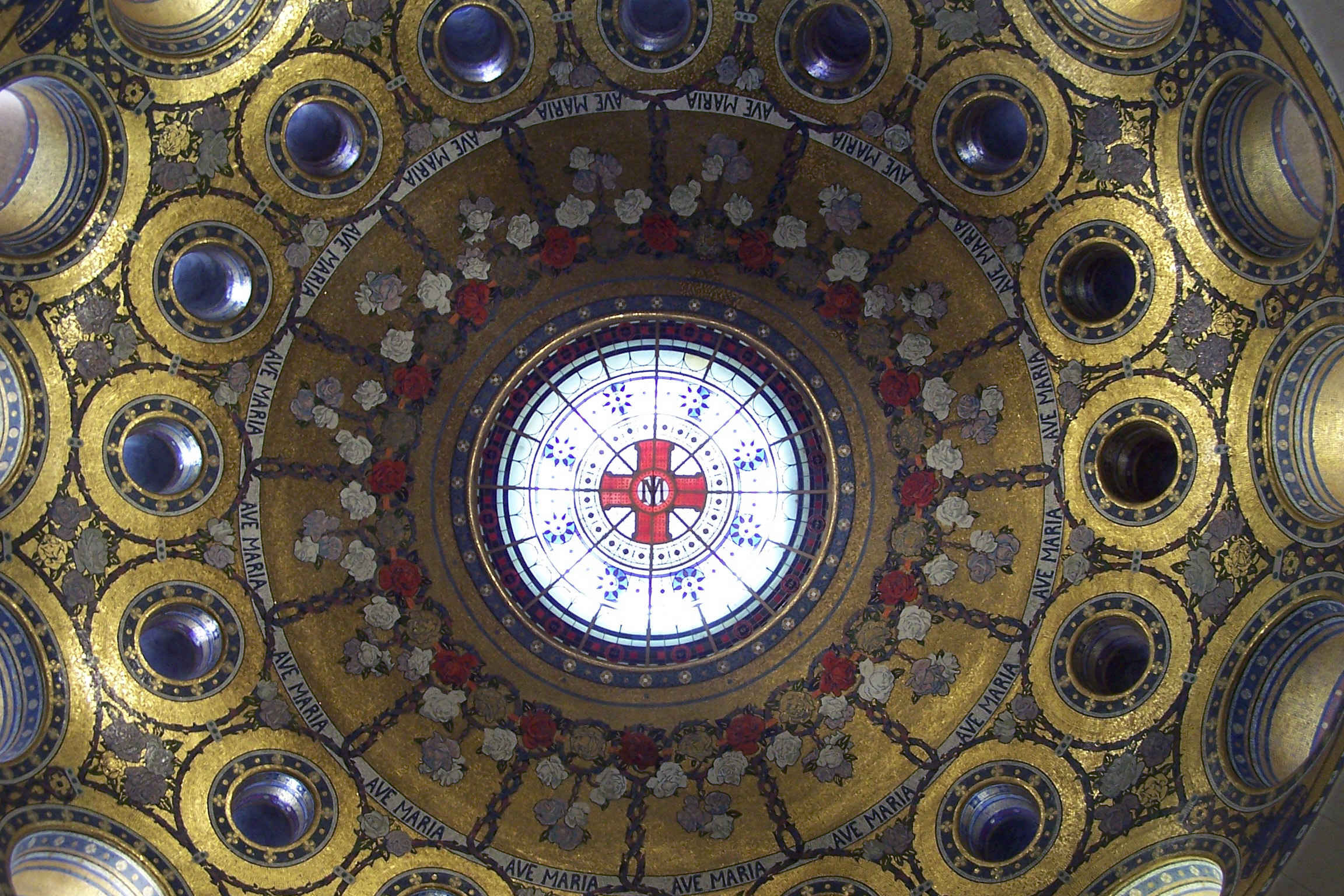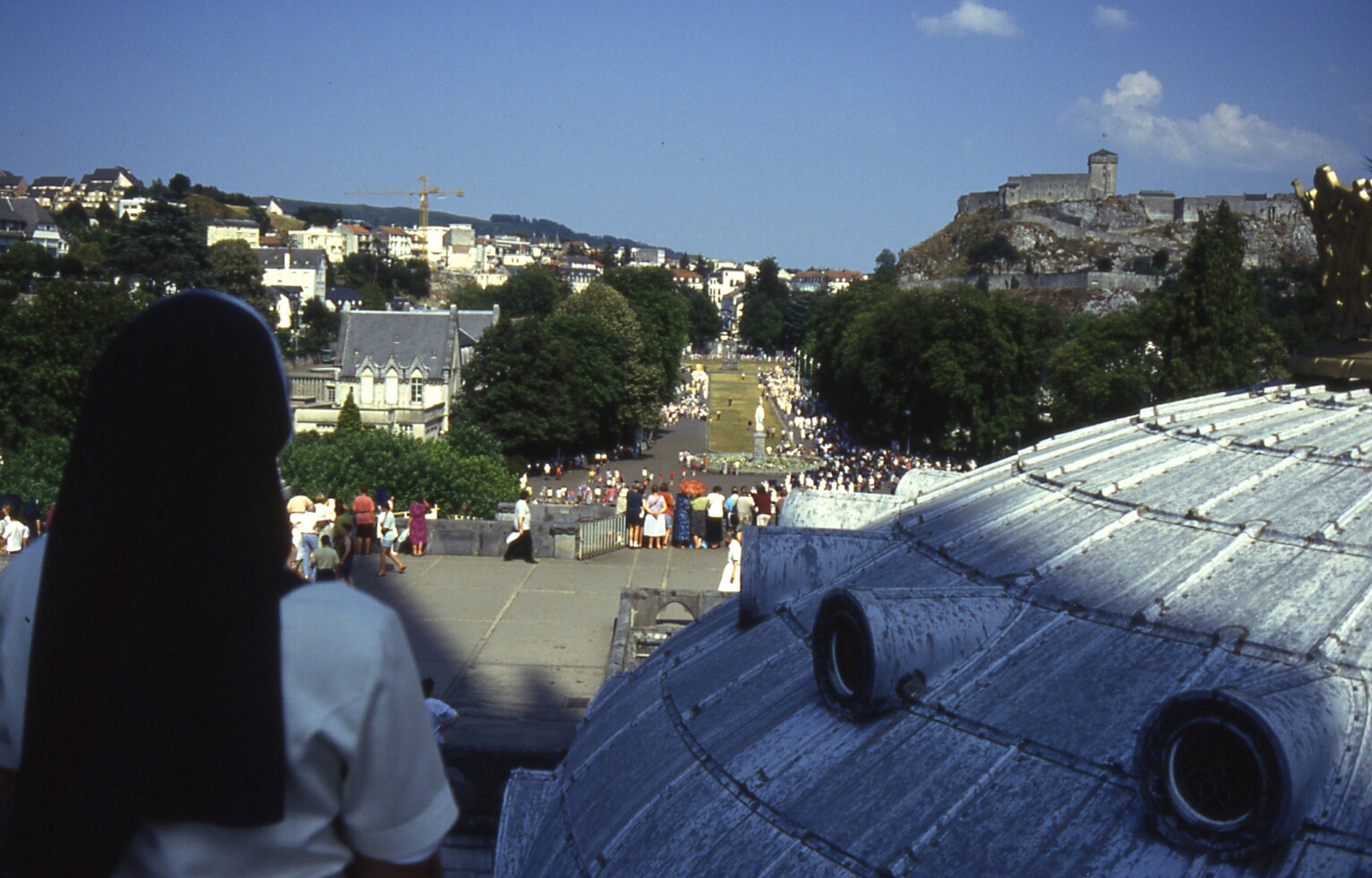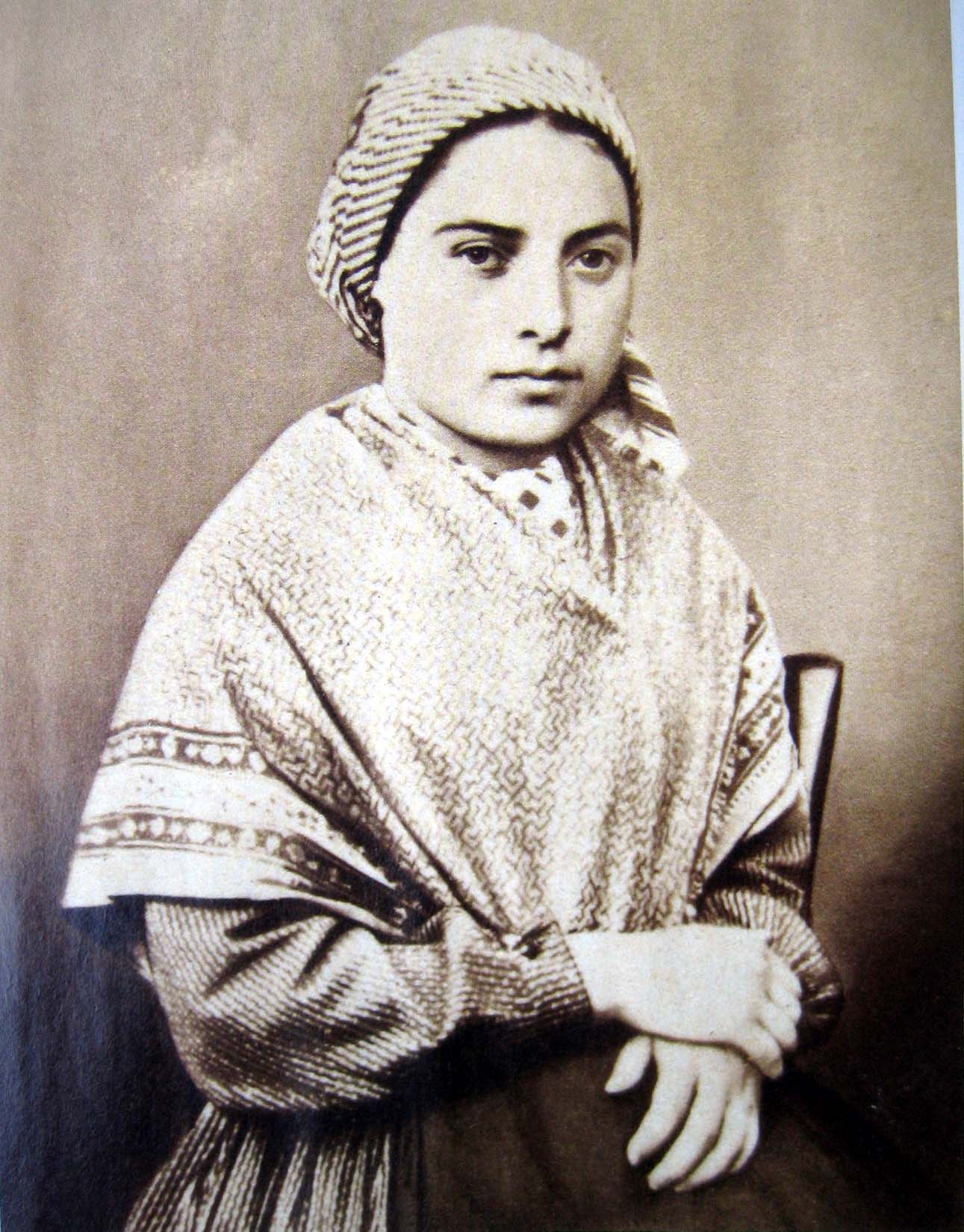|
Rosary Basilica
The Basilica of Our Lady of the Rosary (french: Notre Dame du Rosaire de Lourdes) is a Roman Catholic church and minor basilica within the Sanctuary of Our Lady of Lourdes in France. Its main theme is a celebration and depiction of the Rosary. History The Rosary Basilica is the third of the churches to be completed on the site (after the Crypt and the Upper Basilica). It was designed by architect Leopold Hardy and completed in 1899. It was consecrated in 1901 and has a capacity of 1,500 worshippers. Its style is influenced by Byzantine architecture. In 2006-7 the interior and exterior of the basilica were extensively renovated and the mosaics (many of which were deteriorating) were restored. Nave The nave is open and circular, surmounted by a dome. The dome contains sixteen circular stained glass windows. The fifteen spaces between these windows signify the fifteen decades of the traditional rosary. The nave is surrounded by fifteen smaller side chapels, one for each of the ... [...More Info...] [...Related Items...] OR: [Wikipedia] [Google] [Baidu] |
Lourdes
Lourdes (, also , ; oc, Lorda ) is a market town situated in the Pyrenees. It is part of the Hautes-Pyrénées department in the Occitanie region in southwestern France. Prior to the mid-19th century, the town was best known for the Château fort de Lourdes, a fortified castle that rises up from a rocky escarpment at its center. In 1858 Lourdes rose to prominence in France and abroad due to the Marian apparitions claimed to have been seen by the peasant girl Bernadette Soubirous, who was later canonized. Shortly thereafter the city with the Sanctuary of Our Lady of Lourdes became one of the world's most important sites of pilgrimage and religious tourism. History Antiquity The current municipal area of Lourdes was inhabited in prehistoric times. In Roman times it had to be, since the first century BC, an oppidum hill where today stands the fortress, as is testified by the numerous finds that came to light in the second half of the nineteenth century (remains of walls, fr ... [...More Info...] [...Related Items...] OR: [Wikipedia] [Google] [Baidu] |
Rosary Basilica 5
The Rosary (; la, , in the sense of "crown of roses" or "garland of roses"), also known as the Dominican Rosary, or simply the Rosary, refers to a set of prayers used primarily in the Catholic Church, and to the physical string of knots or beads used to count the component prayers. When referring to the prayer, the word is usually capitalized ("the Rosary", as is customary for other names of prayers, such as "the Lord's Prayer", and "the Hail Mary"); when referring to the prayer beads as an object, it is written with a lower-case initial letter (e.g. "a rosary bead"). The prayers that compose the Rosary are arranged in sets of ten Hail Marys, called "decades". Each decade is preceded by one Lord's Prayer ("Our Father"), and traditionally followed by one Glory Be. Some Catholics also recite the " O my Jesus" prayer after the Glory Be; it is the most well-known of the seven Fátima prayers that appeared in the early 20th century. Rosary prayer beads are an aid for saying these ... [...More Info...] [...Related Items...] OR: [Wikipedia] [Google] [Baidu] |
Shrines To The Virgin Mary
A shrine to the Virgin Mary (or Marian shrine) is a shrine marking an apparition or other miracle ascribed to the Blessed Virgin Mary, or a site on which is centered a historically strong Marian devotion. Such locales are often the destination of pilgrimages. Albania * Sanctuary of Our Lady of Good Counsel, Shkodër Algeria *Notre Dame d'Afrique, Algiers Andorra * Our Lady of Meritxell Argentina *Our Lady of Luján, Luján, Buenos Aires Province * Our Lady of the Rosary of San Nicolás, San Nicolás de los Arroyos *Our Lady of Itatí, Itatí, Corrientes Australia * St Mary's Cathedral, Sydney * Shrine of Our Lady of Yankalilla, South Australia * Shrine of Our Lady of Mercy, Penrose Park, New South Wales * Marian Valley, Shrine of Our Lady Help of Christians, Canungra, Queensland Austria * Basilika Maria Plain, Bergheim, Salzburg * Maria Schmolln, Braunau am Inn District, Upper Austria *Maria Taferl, Melk District, Lower Austria *Mariatrost Basilica, Graz, Styria *Mar ... [...More Info...] [...Related Items...] OR: [Wikipedia] [Google] [Baidu] |
Catholic Church In France
, native_name_lang = fr , image = 060806-France-Paris-Notre Dame.jpg , imagewidth = 200px , alt = , caption = Cathedral Notre-Dame de Paris , abbreviation = , type = National polity , main_classification = Catholic , orientation = Christianity , scripture = Bible , theology = Catholic theology , polity = , governance = CEF , structure = , leader_title = Pope , leader_name = , leader_title1 = President , leader_name1 = Éric de Moulins-Beaufort , leader_title2 = Primate of the Gauls , leader_name2 = Olivier de Germay , leader_title3 = Apostolic Nuncio , leader_name3 = Celestino Migliore , fellowships_type = , fellowships = , fellowships_type1 = , fellowships1 = , division_type = , division = , division_type1 = , divis ... [...More Info...] [...Related Items...] OR: [Wikipedia] [Google] [Baidu] |
Bernadette Soubirous
Bernadette Soubirous (; ; oc, Bernadeta Sobirós ; 7 January 184416 April 1879), also known as Saint Bernadette of Lourdes, was the firstborn daughter of a miller from Lourdes (''Lorda'' in Occitan), in the department of Hautes-Pyrénées in France, and is best known for experiencing Marian apparitions of a "young lady" who asked for a chapel to be built at the nearby cave- grotto at Massabielle. These apparitions occurred between 11 February and 16 July 1858, and the woman who appeared to her identified herself as the "Immaculate Conception." After a canonical investigation, Soubirous's reports were eventually declared "worthy of belief" on 18 February 1862, and the Marian apparition became known as Our Lady of Lourdes. Soubirous’s body has remained internally incorrupt. The Marian shrine at Lourdes (Midi-Pyrénées, from 2016 part of Occitanie) went on to become a major pilgrimage site, attracting over five million pilgrims of all denominations each year. On 8 December 1 ... [...More Info...] [...Related Items...] OR: [Wikipedia] [Google] [Baidu] |
Lourdes Apparitions
The Marian Apparitions at Lourdes were reported in 1858 by Bernadette Soubirous, the 14-year-old daughter of a miller from the town of Lourdes in southern France. From 11 February to 16 July 1858, she reported 18 apparitions of "a Lady". Soubirous described the lady as wearing a white veil and a blue girdle; she had a golden rose on each foot and held a rosary of pearls. After initial skepticism from the Clergy, these claims were eventually declared to be worthy of belief after a canonical investigation, and the apparition is known as Our Lady of Lourdes. According to Soubirous, her visions occurred at the grotto of Massabielle, just outside Lourdes. On 16 July 1858, Soubirous visited the grotto for the last time and said: "I have never seen her so beautiful before." On 18 January 1862, the local bishop declared: "The Virgin Mary did appear indeed to Bernadette Soubirous." In 1958, Pope Pius XII issued the encyclical '' Le pèlerinage de Lourdes'' ("The pilgrimage to Lourdes") ... [...More Info...] [...Related Items...] OR: [Wikipedia] [Google] [Baidu] |
Our Lady Of Lourdes
Our Lady of Lourdes (french: Notre-Dame de Lourdes) is a title of the Virgin Mary. She is venerated under this title by the Roman Catholic church due to her apparitions that occurred in Lourdes, France. The first apparition of 11 February 1858, of which Bernadette Soubirous (age 14) told her mother that a "Lady" spoke to her in the cave of Massabielle ( from the town) while she was gathering firewood with her sister and a friend. Similar apparitions of the "Lady" were reported on 18 occasions that year, until the climax revelation of Our Lady of the Immaculate Conception took place. On 18 January 1862, the local Bishop of Tarbes Bertrand-Sévère Laurence endorsed the veneration of the Blessed Virgin Mary in Lourdes. On 1 February 1876, Pope Pius IX officially granted a decree of canonical coronation to the image as ''Notre-Dame du Saint Rosaire''. The coronation was performed by Cardinal Pier Francesco Meglia at the courtyard of what is now part of the Rosary Basilica on 3 July ... [...More Info...] [...Related Items...] OR: [Wikipedia] [Google] [Baidu] |
Roman Catholic Marian Churches
Catholic Marian churches are religious buildings dedicated to the veneration of the Blessed Virgin Mary. These churches were built throughout the history of the Catholic Church, and today they can be found on every continent including Antarctica. The history of Marian church architecture tells the unfolding story of the development of Catholic Mariology. The construction and dedication of Marian churches is often indicative of the Mariological trends within a period, such as a papal reign. For instance, the 1955 rededication by Pope Pius XII of the church of ''Saint James the Great'' in Montreal, with the new title Mary, Queen of the World, Cathedral, was a reflection of his being called "the most Marian pope". A year earlier, Pope Pius XII had proclaimed that title for the Virgin Mary in his 1954 encyclical '' Ad Caeli Reginam''. This encyclical on the Queen of Heaven is an example of how the interplay between churches and Marian art reinforces the effect of Marian devotions. T ... [...More Info...] [...Related Items...] OR: [Wikipedia] [Google] [Baidu] |
Pope John Paul II
Pope John Paul II ( la, Ioannes Paulus II; it, Giovanni Paolo II; pl, Jan Paweł II; born Karol Józef Wojtyła ; 18 May 19202 April 2005) was the head of the Catholic Church and sovereign of the Vatican City State from 1978 until his death in April 2005, and was later canonised as Pope Saint John Paul II. He was elected pope by the second papal conclave of 1978, which was called after John Paul I, who had been elected in August to succeed Pope Paul VI, died after 33 days. Cardinal Wojtyła was elected on the third day of the conclave and adopted the name of his predecessor in tribute to him. Born in Poland, John Paul II was the first non-Italian pope since Adrian VI in the 16th century and the second-longest-serving pope after Pius IX in modern history. John Paul II attempted to improve the Catholic Church's relations with Judaism, Islam, and the Eastern Orthodox Church. He maintained the church's previous positions on such matters as abortion, artificia ... [...More Info...] [...Related Items...] OR: [Wikipedia] [Google] [Baidu] |
Philippe Pétain
Henri Philippe Benoni Omer Pétain (24 April 1856 – 23 July 1951), commonly known as Philippe Pétain (, ) or Marshal Pétain (french: Maréchal Pétain), was a French general who attained the position of Marshal of France at the end of World War I, during which he became known as The Lion of Verdun (french: le lion de Verdun). From 1940 to 1944, during World War II, he served as head of the collaborationist regime of Vichy France. Pétain, who was 84 years old in 1940, remains the oldest person to become the head of state of France. During World War I, Pétain led the French Army to victory at the nine-month-long Battle of Verdun. After the failed Nivelle Offensive and subsequent mutinies he was appointed Commander-in-Chief and succeeded in repairing the army's confidence. Pétain remained in command for the rest of the war and emerged as a national hero. During the interwar period he was head of the peacetime French Army, commanded joint Franco-Spanish operations during the ... [...More Info...] [...Related Items...] OR: [Wikipedia] [Google] [Baidu] |
Saint Dominic
Saint Dominic ( es, Santo Domingo; 8 August 1170 – 6 August 1221), also known as Dominic de Guzmán (), was a Castilian Catholic priest, mystic, the founder of the Dominican Order and is the patron saint of astronomers and natural scientists. He is alternatively called Dominic of Osma, Dominic of Caleruega, and Domingo Félix de Guzmán. Life Birth and early life Dominic was born in Caleruega,"Saint Dominic", Lay Dominicans halfway between and in , [...More Info...] [...Related Items...] OR: [Wikipedia] [Google] [Baidu] |
Gold Crown - Basilica Of The Immaculate Conception - Lourdes 2014
Gold is a chemical element with the symbol Au (from la, aurum) and atomic number 79. This makes it one of the higher atomic number elements that occur naturally. It is a bright, slightly orange-yellow, dense, soft, malleable, and ductile metal in a pure form. Chemically, gold is a transition metal and a group 11 element. It is one of the least reactive chemical elements and is solid under standard conditions. Gold often occurs in free elemental (native state), as nuggets or grains, in rocks, veins, and alluvial deposits. It occurs in a solid solution series with the native element silver (as electrum), naturally alloyed with other metals like copper and palladium, and mineral inclusions such as within pyrite. Less commonly, it occurs in minerals as gold compounds, often with tellurium (gold tellurides). Gold is resistant to most acids, though it does dissolve in aqua regia (a mixture of nitric acid and hydrochloric acid), forming a soluble tetrachloroaurate anion. Gold is in ... [...More Info...] [...Related Items...] OR: [Wikipedia] [Google] [Baidu] |


.jpg)







